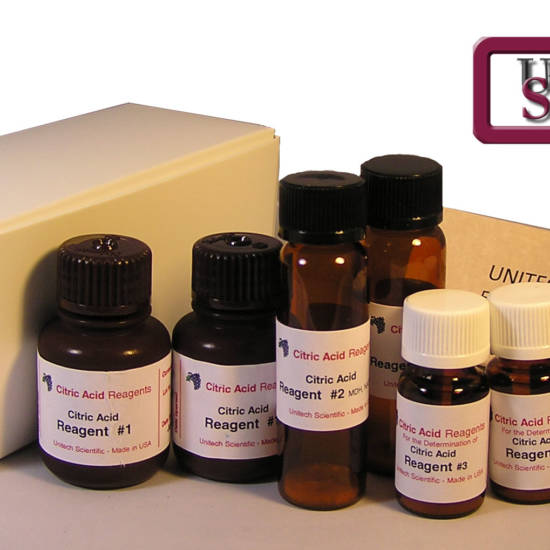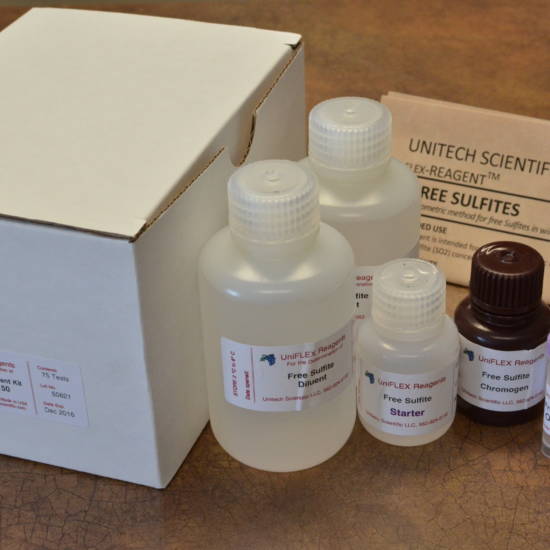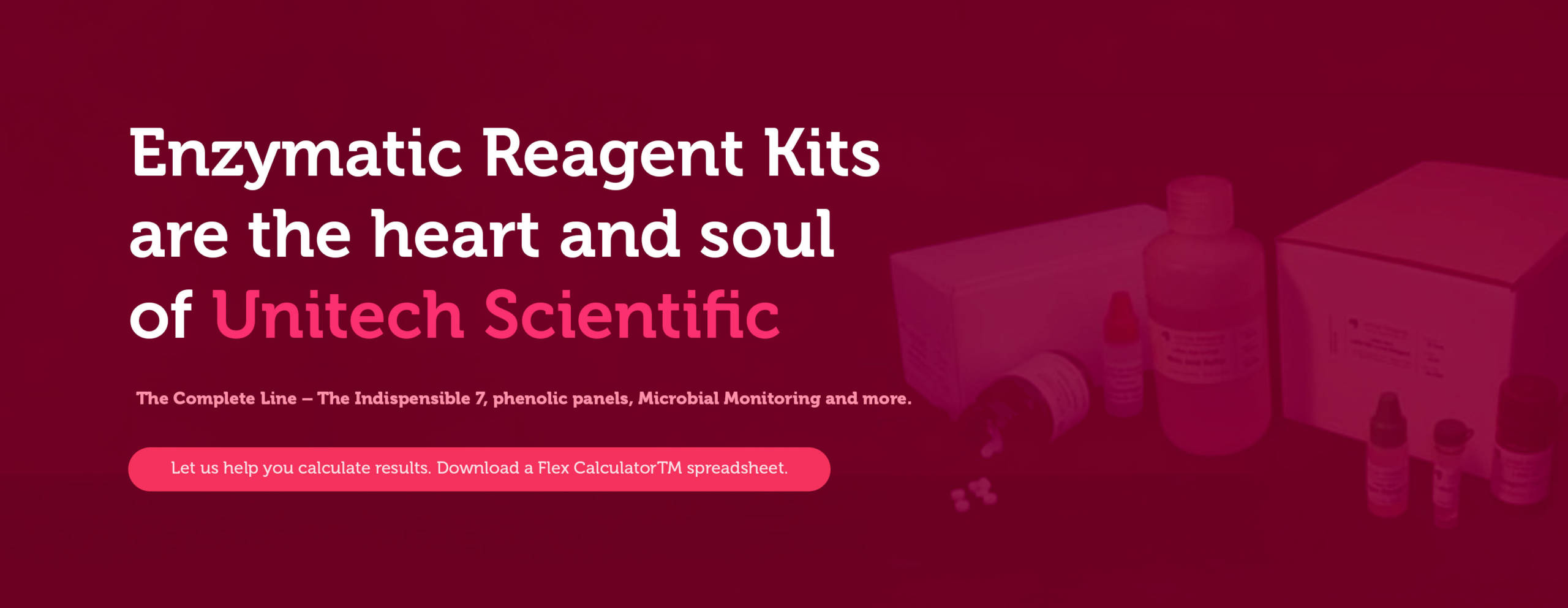
INFO
UniTAB & UniFLEX
We offer 2 convenient formats, UniTAB & UniFLEX kits
Choice of Kit Sizes (30-Test, 75-Test, 250-Test kits). Our Kits are stable for up to 2-years from manufacture.
Methods & Linearity
Consider Analyzers & Automation
UniTAB Tablet Reagent Kits – Innovative & Simple
Consistent protocols: dissolve 1 tablet/5 mL
Convenient dropper vials for enzyme trigger reagent 1 drop of enzyme added per reaction
Ammonia UniTab
D-Glucose/Fructose UniTab
L-Malic Acid UniTab
Primary Amino Nitrogen UniTab (=NOPA, Nitrogen by OPA)
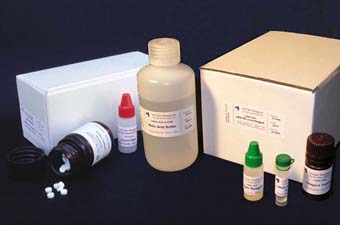
UniFlex Reagent Kits – Convenient, Liquid Stabilized
Consistent protocols
Liquid, ready-to-use components with ‘traditional’ format; separate enzymes for flexible manual and automated protocols.
Acetic Acid
D-Glucose/Fructose
D-Lactic Acid
L-Malic Acid
Free Sulfites
Total Sulfites
Tartaric Acid
Phenolics Panel, Anthocyanins & more
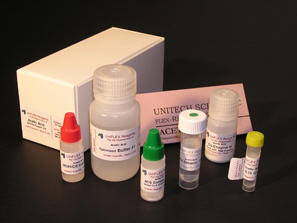
UniTAB KITS
Ammonia UniTab Reagent (=AMM)
An enzymatic test kit for determination of ammonia in grape juice, fermenting wine, and other liquid samples. Contains enzymes, substrates and buffer components in tablet form and as aqueous solutions and suspensions.
Each reagent tablet is dissolved in 5 mL of deionized water, permitting the user to prepare only as much working reagent as required for daily use. One drop of Trigger (start) reagent is sufficient to initiate the reaction. This reagent is linear to approximately 180 mg/L. Ask about our “Extended Range AMM” reagent kit, linear to 350 mg/L (with sensitivity to 10 mg/L)
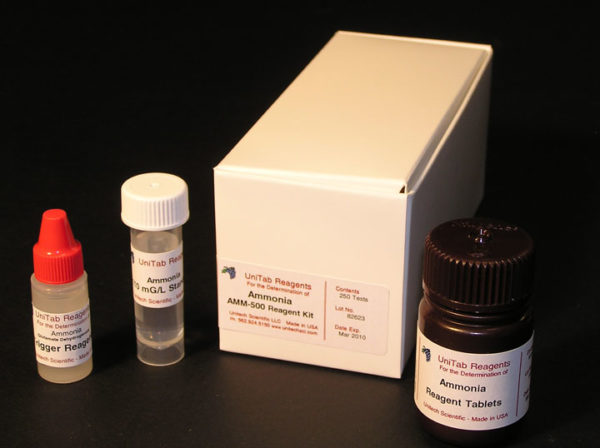
Amm-500 (250 tests)
Primary Amino Nitrogen UniTab Reagent (=PAN)
Determine primary amino nitrogen compounds (or Nitrogen by OPA = NOPA) in grape juice & fermenting wine/must samples.
Contains buffered N-Acetyl-l-cysteine (NAC) tablets, ophthaldialdehyde (OPA), and Nitrogen Standard Solution. Each tablet is dissolved in 5 mL of deionized water, permitting the user to prepare only as much working reagent as required for daily use. This “fast blanking” method only requires working reagent (the blank reagent solution is no longer required). This procedure is based on a published method from UC Davis.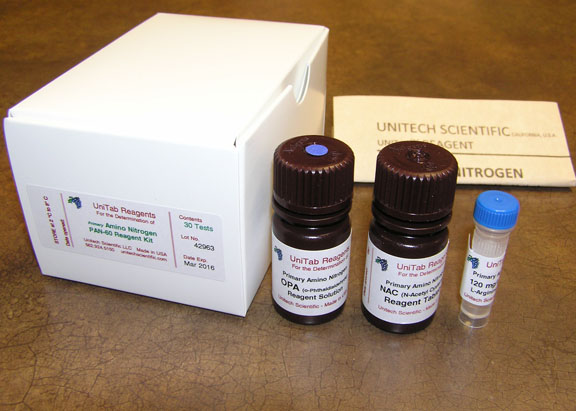
PAN-60 (30 tests)
Why Measure Yeast Assimilable Nitrogen compounds (Ammonia Nitrogen +
Primary Amino Nitrogen)? Typical total YAN ranges from 40 – 560mg/L; both yeast & M-L Bacteria require available nitrogen for effective fermentation.
- Low Ammonia Nitrogen & PAN levels have been associated with sluggish fermentation and sensory imperfections.
- Nitrogen content may be supplemented e.g. with diammonium phosphate (DAP.)
- Routine and excessive nitrogen supplementation should be avoided, since residual nitrogen supports the growth of unwanted wine spoilage organisms such as Brettanomyces, Lactic Acid Bacteria, Acetobacter, etc.
D-Glucose/Fructose UniTab Reagent (=GF)
An enzymatic test kit for determination of total D-glucose plus D-fructose (reducing sugars) in grape juice, fermenting wine, and other samples.
Contains enzymes, substrates and buffer components in tablet form; each reagent tablet is dissolved in 5 mL of deionized water, permitting the user to prepare only as much working reagent as required for daily use. One drop of Trigger (start enzymes Hexokinase and PGI)) reagent is sufficient to initiate the reaction. The D-Fructose Standard, provided in addition to the D-Glucose Standard, is of particular benefit in monitoring the (slower) PGI mediated reaction.
GF-60 (30 tests)
Reducing sugars are the predominant soluble components of soft fruits, with sucrose in low amounts. D-Glucose and D-fructose are the predominant reducing sugars in grape and other fruit juices. The ratio of glucose to fructose in mature grapes is “1”, but ranges from 0.74 – 1.12 according to variety, maturity and fermentation conditions. In ‘stuck fermentations’, D-Fructose often predominates, since D-Glucose is the preferred energy source for yeast.
L-Malic Acid Unitab Reagent (=LMA)
An enzymatic test kit for determination of L-malic acid in grape juice, fermenting wine, and other liquid samples and other samples. Contains enzymes, substrates and buffer components in tablet form and as aqueous solutions and suspensions.
Each reagent tablet is dissolved in 5 mL of Malic Acid Buffer, permitting the user to prepare only as much working reagent as required for daily use. One drop of Trigger (start enzymes Malate Dehydrogenase and GOT)) reagent is sufficient to initiate the reaction. ) reagent is sufficient to initiate the reaction.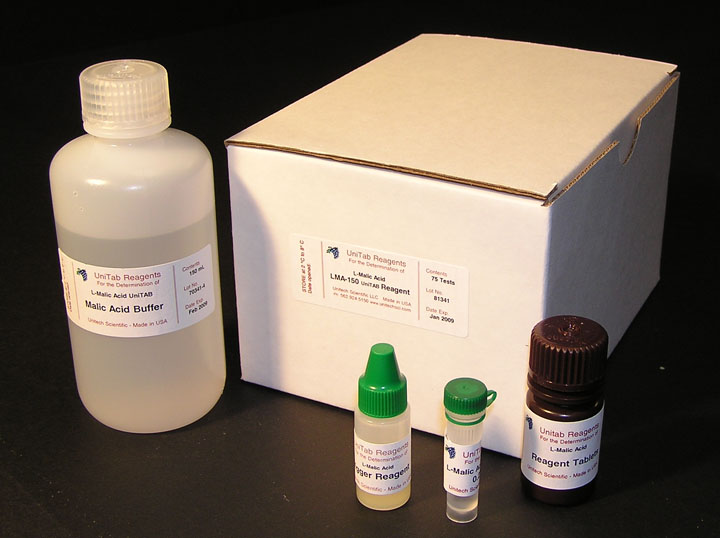
LMA-150 (75 tests)
L-malic acid is present in grapes, apples and other fruit and vegetables. In grape juice, its concentration drops from (as high as) 8 to perhaps 1 g/L in grape must as the ripening process proceeds; L-Malic levels, along with sugar concentration, are typically used to gauge ripeness for wine production. Up to 30% of the malic acid may be consumed by yeast fermentation. A secondary fermentation is typical in wine; L-malic acid is converted to L-lactic acid and carbon dioxide by lactic bacteria. Mali-lactic fermentation can be prevented by filtration and increased sulfite.
Acetic Acid UniFlex Reagent (=AA-F)
An enzymatic test kit for determination of acetic acid in foods, beverages and other samples. Contains ready to use aqueous buffer,
MDH/Citrate synthase enzyme suspension, ACS enzyme diluent, and acetic acid standard. Also contains in dry form Acetyl Co-A Synthetase, which is dissolved in ACS enzyme diluent, and Coenzyme powder, which is dissolve in deionized water. Features:- Reconstituted Coenzyme Solution and Acetyl Co-A Synthetase Solutions have extended shelf life. Both are stable for 3 months following dissolution.

AA-F150 (75 tests)
2. The Flex CalculatorTM, which automatically calculates acetic acid content in G/L based on the acetic acid ΔABS and extinction coefficient equations. The user simply enters A0,A1, and A2 values into the Flex CalculatorTM The Calculator assists in estimating free acetic acid by providing a plot to facilitate the extrapolation of A2 absorbance values at the time of ACS enzyme addition.
D-Glucose/Fructose UniFlex Reagent (=GF-F)
An enzymatic test kit for determination of both D-glucose and D-fructose (reducing sugars) in foods, beverages and other samples.
Contains ready-to-use Buffer solution and two enzyme suspensions (Hexokinase/G6PDH and PGI), permitting independent determinations of D-glucose and D-fructose. Also contains D-fructose and D-glucose standards. The Fructose Standard is of particular benefit in monitoring the (slower) PGI mediated reaction.
Reducing sugars are the predominant soluble components of soft fruits, with sucrose in low amounts.
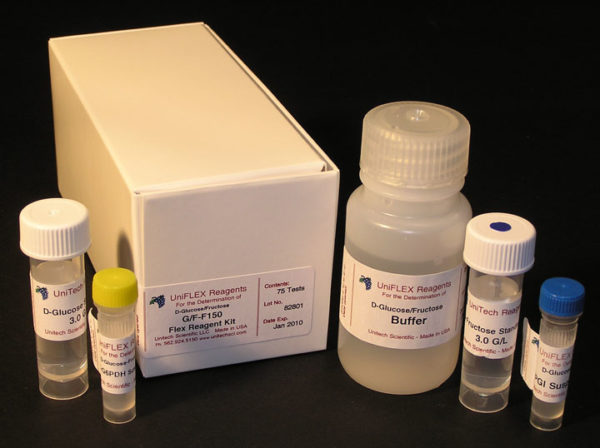
GF-F150 (75 tests)
D-Glucose and D-fructose are the predominant reducing sugars in grape and other fruit juices. The ratio of glucose to fructose in mature grapes is “1”, but ranges from 0.74 – 1.12 according to variety, maturity and fermentation conditions. In ‘stuck fermentations’, D-Fructose often predominates, since D-Glucose is the preferred energy source for yeast.
L-Malic Acid UniFlex Reagent (=LMA-F)
An enzymatic test kit for determination of L-malic acid in foods, beverages and other samples.
Contains read-to-use Buffer, NAD Subtstrate solution, two enzyme suspensions (Malate Dehydrogenase and GOT), as well as a L-Malic Acid Standard.
L-malic acid is present in grapes, apples and other fruit and vegetables. In grape juice, its concentration drops from (as high as) 8 to perhaps 1 g/L in grape must as the ripening process proceeds; L-Malic levels, along with sugar concentration, are typically used to gauge ripeness for wine production. Up to 30% of the malic acid may be consumed by yeast fermentation.
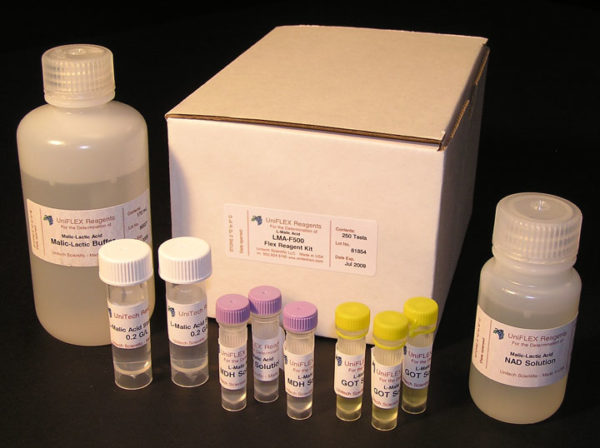
LMA-F500 (250 tests)
Tartaric Acid UniFlex Reagent Kit (=TA-F)
For the determination of tartaric acid in wine and other liquid samples. In the presence of tartaric acid, the reagent forms an orange/red color which is read photometrically.
Contains Tartaric Acid “Reagent A” and NaOH “Reagent B”. A Tartaric Acid Standard at 3G/L is also provided.
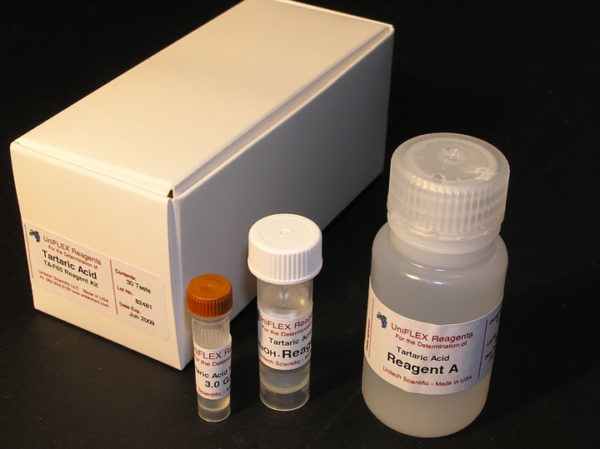
taF60
New WINE PHENOLICS kits
Anthocyanins, Color Density, Hue, Bleaching
Measurement of phenolics during harvest & vinification can provide valuable information for optimizing and controling wine quality.
Phenolics in wine include tannins, anthocyanins, polymeric pigments and monomeric phenols (e.g. caffeic acid, caftaric acid, catechins, quercetin, kaempherol, and gallic acid) and are responsible for wine color, bitterness, and astringency. Color and flavor profiles of finished wine are affected by grape selection and winemaking techniques. Total phenol content, as well as color and hue data, can provide valuable information for optimizing these processes. Contact Unitech to automate these tests on your ChemWell for WineTM autoanalyzer.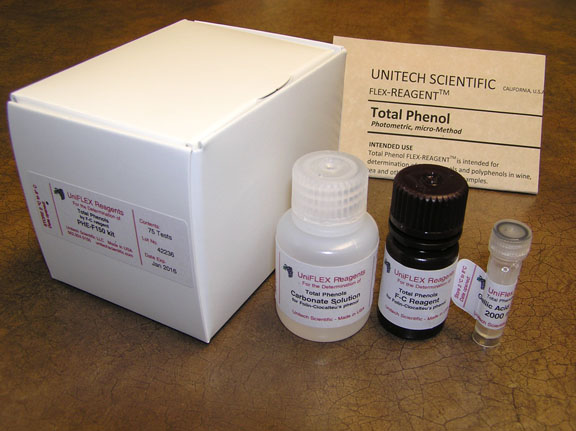
PHE-F150 (75 tests)
ONLINE SHOP
Check Our Products
Reagents, instruments, distribution
wine producing,
spare
parts and a guarantee.
Piter Geret
Repair Expert
Reagents, instruments, distribution, wine producing, wine testing
Piter Geret
Repair Expert

